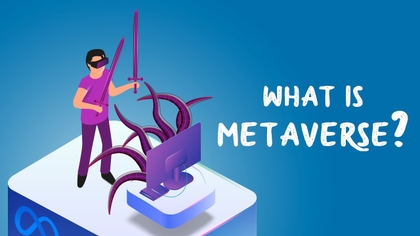It is undeniable that 2021 was one of the best years for crypto, since the inception of Bitcoin all the way back in 2009. This is evident both in regards to innovations seen within the sector, as well as the prices of the different assets available across the market.
One of the more-successful of these assets is Ethereum. Hailed by many as one of the grand staples of the crypto industry, Ethereum is home to a wide array of different crypto tokens, business projects, stablecoins, and more.
Lately, it has become evident that, in 2022, Ethereum might become even more popular due to something known as metaverses.

Did you know?
Want to get smarter & wealthier with crypto?
Subscribe - We publish new crypto explainer videos every week!
What is the Metaverse? (Meaning + Animated Examples)


In layman’s terms, metaverses are fully-fledged virtual realities. While they have been popping up in the news for the past few years, with the recent announcements from Facebook’s own Mark Zuckenberg, metaverses have become an even hotter topic for discussion.
What do crypto and metaverses have to do with one another, though?
It is a well-known fact that the aforementioned metaverses are going to need two big features - some sort of a monetization model, as well as a way to aggregate, store, and manage data. If you know anything about crypto, you’re also aware of the fact that Ethereum seems to fit perfectly within these requirements.
Apart from its own cryptocurrency called Ether, Ethereum houses a huge array of different projects. Among these projects, you’ll find things such as the most popular stablecoins, tokens representing global projects, and even NFTs and NFT-based games.

The latter are especially relevant in regards to the topic of metaverses. With the rise of NFT gaming, the concept of “playing-to-earn” has seen a surge in popularity, as well. It refers to playing NFT-driven, Ethereum-based games in order to earn certain rewards, which can then be exchanged for cryptocurrencies and tokens (most often, this would be Ether). Axie Infinity is one of the best-known examples of this concept.
This crypto-based NFT gaming showcases the potential that the technology behind Ethereum has, in regards to metaverses. Admittedly, however, there have been critics that are skeptical about Ethereum’s role in the topic, too.
Most of the criticism stems from two major topics - the gas fees related to Ether- and ERC-20 token-involving transactions, and the scalability aspect of the technology. Critics note that both problems need to be addressed in order for Ethereum to become a viable solution for metaverse integrations.
On the flip side, both scalability and gas fee issues should be mitigated with the issuance of ETH 2.0, the major update to Ethereum that is said to finish sometime in 2022. If all goes according to plan, Ethereum will move away from Proof-of-Work, and enter the Proof-of-Stake consensus algorithm. This will improve both the scalability and data processing features of the technology, as well as solve the huge gas fee problem, at least theoretically.






















